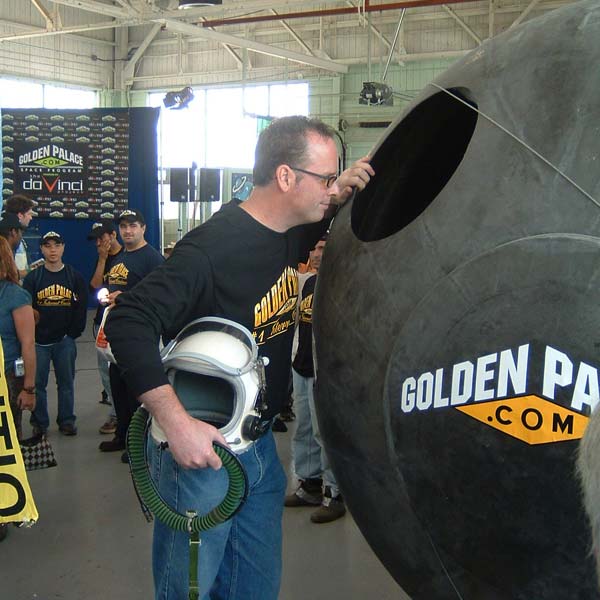Canadian X Prize Team Secures Launch Window

The Canadian government has officially approved a launch application for what could be the first privately sponsored manned spaceflights staged from the North American country.
Transport Canada, the country's transportation agency, announced today that it has approved a launch window for two manned spaceflights by the GoldenPalace.com/da Vinci Project, a Toronto-based team of rocketeers competing in an international suborbital space race.
According to Transport Canada's Launch Safety Office, the da Vinci team has a window extending from Oct. 2 to Nov. 1 to make two launches using its piloted space vehicle Wild Fire Mark VI.
"We've come a long way in a short amount of time," said da Vinci team leader Brian Feeney in a Sept. 30 statement to X Prize followers. "We are committed to fly."
Feeney's team is one of more than two dozen participating in the Ansari X Prize competition, a contest to privately develop reusable, human-carrying suborbital vehicles. The X Prize challenges competitors to develop three-person spacecraft capable of launching to altitude of at least 62 miles (100 kilometers) twice in two weeks. The first to do so snags $10 million.
One team, Mojave Aerospace Ventures, LLC of Mojave, California led by aerospace veteran Burt Rutan, has already succeeded in making its first X Prize flight.
Pilot and private civilian astronaut Mike Melvill flew the group's SpaceShipOne vehicle to suborbital space on Sept. 29. A second flight, which would secure the X Prize for Rutan's team if successful, is set for Oct. 4.
Breaking space news, the latest updates on rocket launches, skywatching events and more!
Like SpaceShipOne, Wild Fire is designed to be launched from the air after being hoisted into launch position - about 80,000 feet (24,384 meters) - via helium balloon.
Feeney, who intends to pilot Wild Fire during its first flight, and his team planned to make their first space shot on Oct. 2, but revised their launch date due to the availability of key spacecraft components. Wild Fire's launch countdown is currently on hold at T - 7 days.
Today's announcement by Transport Canada gives da Vinci Project team members a month-long window to make their two space shots, both staged from Kindersley Airport near the town of Kindersley in the Canadian province of Saskatchewan.
"Transport Canada has reviewed and approved the mission control documents and is satisfied that all the documentation, procedures and insurance are in order," Transport Canada officials said in an Oct. 1 statement. The Canadian agency is working with the group NAV CANADA to alert pilots of a Wild Fire launch and clear the necessary airspace, according to the statement.
There are, however, conditions to the launch approval, some of which include at least (5 kilometers) of visibility on launch day, safe wind conditions for both the Wild Fire spacecraft and its helium balloon carrier and the presence of a range safety officer during launch.
In a Sept. 24 interview, Feeney told SPACE.com he had "no concerns" of securing flight insurance, launch approval and meeting other government regulations.

Tariq is the award-winning Editor-in-Chief of Space.com and joined the team in 2001. He covers human spaceflight, as well as skywatching and entertainment. He became Space.com's Editor-in-Chief in 2019. Before joining Space.com, Tariq was a staff reporter for The Los Angeles Times covering education and city beats in La Habra, Fullerton and Huntington Beach. He's a recipient of the 2022 Harry Kolcum Award for excellence in space reporting and the 2025 Space Pioneer Award from the National Space Society. He is an Eagle Scout and Space Camp alum with journalism degrees from the USC and NYU. You can find Tariq at Space.com and as the co-host to the This Week In Space podcast on the TWiT network. To see his latest project, you can follow Tariq on Twitter @tariqjmalik.
